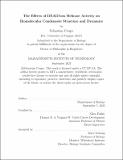The Effects of DEAD-box Helicase Activity on Biomolecular Condensate Structure and Dynamics
Author(s)
Coupe, Sebastian
DownloadThesis PDF (30.74Mb)
Advisor
Fakhri, Nikta
Terms of use
Metadata
Show full item recordAbstract
Biomolecular condensates are membraneless organelles which help spatiotemporally organize the biochemistry of the cytoplasm and nucleoplasm. These bodies are composed of specific proteins and RNA which self-associate to drive condensate formation. The strengths, timescales, and valence of the biomolecular interactions which drive condensate formation also have consequences for the properties of these bodies. In the context of subcellular reaction crucibles, condensate dynamics may hold the key to understanding the regulation of their function. Enzymatic processes which control condensate properties are of particular interest to biologists attempting to understand the function of biomolecular condensates, bioengineers looking for control points in manipulating condensates, and physicists interested in active materials. In this work, we study how DEAD-box helicases dictate condensate structure and dynamics via their enzyme-dependent RNA interactions and RNA remodeling activity. First, we show how a DEAD-box helicase’s nucleotide dependent RNA-binding dynamics can give rise to new effective microscopic structures. The changes microstructure in turn have dramatic consequences for condensate material state. We then uncover how DEAD-box unwinding can influence RNA structures that form within biomolecular condensates. Changes in helicase activity give rise to changes in condensate composition, time-dependent structure, and time-dependent dynamics. Lastly we demonstrate that a small molecule which interacts with the active site of LAF-1 promotes condensate aging. This suggests a new mechanism for perturbing condensate properties, which we believe involves restricting protein conformational dynamics. This work uncovers basic principles of DEAD-box controlled condensate properties as well as more general principles of condensate and hydrogel design. It also establishes LAF- 1 and DEAD-box helicases as an interesting avenue of active matter research, where activity affects phase behavior and emergent material properties.
Date issued
2023-09Department
Massachusetts Institute of Technology. Department of BiologyPublisher
Massachusetts Institute of Technology